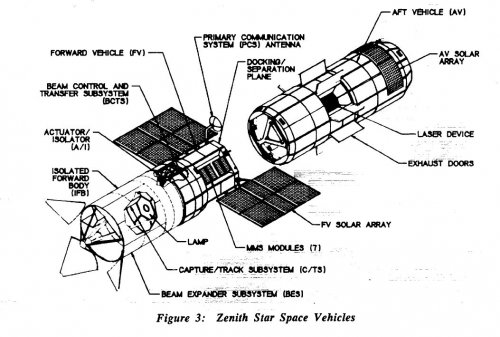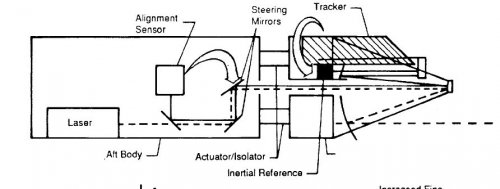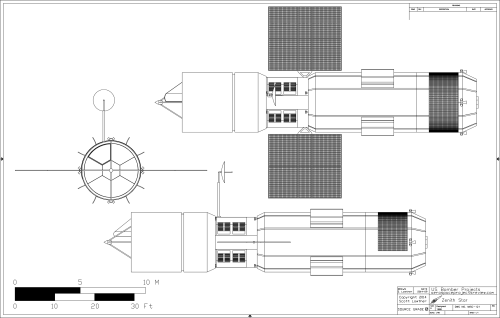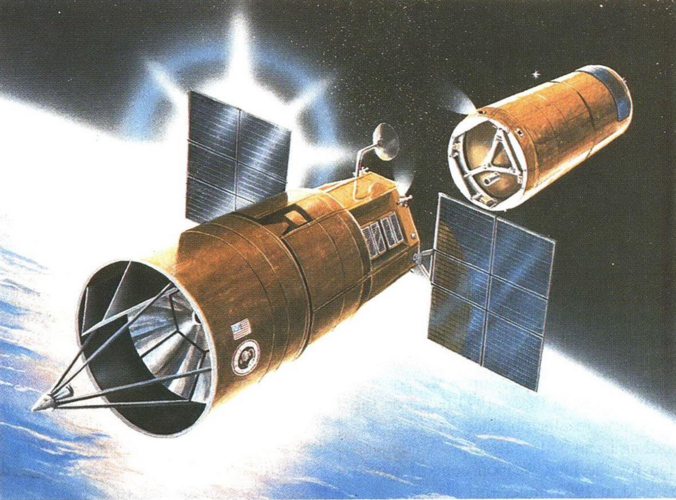Last edited by a moderator:
You are using an out of date browser. It may not display this or other websites correctly.
You should upgrade or use an alternative browser.
You should upgrade or use an alternative browser.
Zenith Star
- Joined
- 13 August 2007
- Messages
- 8,411
- Reaction score
- 10,889
US SDI Experiment project
in internet wrong labeled ALPHA Laser
because Zenith Star use the Alpha Laser technology, who gets its energy from a chemical reaction.
the laser beam is obtains by mixing hydrogen and fluoride to form hydrogen fluoride molecules.
this is vented in to space as laser cooling
weighed 39.4 metric tons,
to be launched at one time by a Barbarian launch vehicle
or in two elements aboard a Titan 4 around 1995
Test include the Laser shooting on test targets, test of sensors and targeting systems.
if the test had be a success a advance version had be deployed after year 2000
in internet wrong labeled ALPHA Laser
because Zenith Star use the Alpha Laser technology, who gets its energy from a chemical reaction.
the laser beam is obtains by mixing hydrogen and fluoride to form hydrogen fluoride molecules.
this is vented in to space as laser cooling
weighed 39.4 metric tons,
to be launched at one time by a Barbarian launch vehicle
or in two elements aboard a Titan 4 around 1995
Test include the Laser shooting on test targets, test of sensors and targeting systems.
if the test had be a success a advance version had be deployed after year 2000
- Joined
- 1 April 2006
- Messages
- 11,369
- Reaction score
- 10,174
Zenith Star: A Structural Control Challenge
L. A. Morine
Martin Marietta Aerospace Group
Denver, Colorado
3rd Annual NASA/DOD CSI Conference
San Diego, California
January 29 - February 2, 1989
http://hdl.handle.net/2060/19900011748
L. A. Morine
Martin Marietta Aerospace Group
Denver, Colorado
3rd Annual NASA/DOD CSI Conference
San Diego, California
January 29 - February 2, 1989
http://hdl.handle.net/2060/19900011748
Attachments
archipeppe
ACCESS: Top Secret
- Joined
- 18 October 2007
- Messages
- 2,431
- Reaction score
- 3,146
Incredible finding!!!!
Great Gregory (as usual.....)!!!
Great Gregory (as usual.....)!!!
A diagram of Zenith Star based on numerous sources. This is a first cut of a diagram that may or may not appear in a book idea I've been pondering on the various vehicles and weapons of the Star Wars/SDI/BMD programs. If it comes out, it'll be a good long while. But the diagram as it currently stands is available in high rez (and as a DXF) over HERE... at least for another week or two.
Attachments
- Joined
- 6 August 2007
- Messages
- 3,874
- Reaction score
- 5,869
Might make an interesting field trip. The mirror has been in their possession for some time, perhaps photos could be arranged.
https://www.fbo.gov/index?s=opportunity&mode=form&tab=core&id=25c15ad336bb8715014a89c3d444ffa9&_cview=0
https://www.fbo.gov/index?s=opportunity&mode=form&tab=core&id=25c15ad336bb8715014a89c3d444ffa9&_cview=0
- Joined
- 1 April 2006
- Messages
- 11,369
- Reaction score
- 10,174
- Joined
- 29 July 2009
- Messages
- 1,767
- Reaction score
- 2,456
Follow link to VIMEO video (Orionblamblam's article)
- Joined
- 29 July 2009
- Messages
- 1,767
- Reaction score
- 2,456
GAO Report on Zenith Star
Attachments
jeffb
ACCESS: Top Secret
- Joined
- 7 October 2012
- Messages
- 1,273
- Reaction score
- 1,908
Of course you know where it will all end, right?
View: https://www.youtube.com/watch?v=raWZraPHLqM&ab_channel=DougTischler
Forest Green
ACCESS: Above Top Secret
- Joined
- 11 June 2019
- Messages
- 9,432
- Reaction score
- 17,176
- Joined
- 26 September 2008
- Messages
- 1,960
- Reaction score
- 744
From Lyndon LaRouche's "Science and Technology" magazine. Beware.
That was the only good thing that came out of his outfit...For some reason people called him a Libertarian---he might have been called an Old Spacer who wanted tax dollars going to infrastructure---he was the last of the FDR men---though with his own oddball Moonie type ideas and such.
Scott's other drawing:
The Mock-up
Operational model here
I like this better:
Shoot cube-sats out when not shooting flechettes down at hypersonic munitions.
All space-spending should be of a dual-nature---serving both civilian and military concerns. The rail-gun above is better at hitting hypersonics---but at cube-sat launch.
Good for the pellet stream concept here too:
This NAIC candidate:

 www.nasa.gov
www.nasa.gov
Would give new life to space-based lasers---but also for space-based radars, astronomy--solar powersats---and more.
Of course, Ares V could have launched an even bigger one:
Wish-list missions for the Ares V range from a 150-meter-wide (492 ft) radio telescope dish to detect whispers from deep space to a 5-meter cube of super-pure water encased in light detectors to assay cosmic rays by their light flashes as they crash through the water. An optical telescope with a primary mirror up to 8 m (26 ft.) in diameter could search star populations in the Milky Way and nearby galaxies for the "fossil record" of their evolution. It could also hunt for "Earthshine spectra," faint signs of life in the light reflected by exoplanets.
SLS can pick up the slack since Elon seems more interested in adding to his rocket garden--while we KNOW the next SLS cores will fly.
Scott's other drawing:
The Mock-up
Operational model here
I like this better:
Shoot cube-sats out when not shooting flechettes down at hypersonic munitions.
All space-spending should be of a dual-nature---serving both civilian and military concerns. The rail-gun above is better at hitting hypersonics---but at cube-sat launch.
Good for the pellet stream concept here too:
A Novel Propulsion System Would Hurl Hypervelocity Pellets at a Spacecraft to Speed it up - Cosmoquest Forum
A new proposal for a pellet-beam spacecraft could enable interstellar missions and a Solar Gravitational Lens in a matter of decades. The post A Novel Propulsion System Would Hurl Hypervelocity Pellets at a Spacecraft to Speed it up...
forum.cosmoquest.org
This NAIC candidate:

Bend-Forming of Large Electrostatically Actuated Space Structures - NASA
Current large reflectors used in space-based sensing and comms applications are packaged for launch, then deployed once on orbit. Size and surface precision
Would give new life to space-based lasers---but also for space-based radars, astronomy--solar powersats---and more.
Of course, Ares V could have launched an even bigger one:
Wish-list missions for the Ares V range from a 150-meter-wide (492 ft) radio telescope dish to detect whispers from deep space to a 5-meter cube of super-pure water encased in light detectors to assay cosmic rays by their light flashes as they crash through the water. An optical telescope with a primary mirror up to 8 m (26 ft.) in diameter could search star populations in the Milky Way and nearby galaxies for the "fossil record" of their evolution. It could also hunt for "Earthshine spectra," faint signs of life in the light reflected by exoplanets.
SLS can pick up the slack since Elon seems more interested in adding to his rocket garden--while we KNOW the next SLS cores will fly.
Last edited:
1. Not true. Just because a big rocket exists doesn't mean it could be used.1. Would give new life to space-based lasers---but also for space-based radars, astronomy--solar powersats---and more.
2. Of course, Ares V could have launched an even bigger one:
3. SLS can pick up the slack since Elon seems more interested in adding to his rocket garden--while we KNOW the next SLS cores will fly.
2. And what is the point of that?
3. Not true.
a. There is no slack to pickup.
b. Artemis 2 is too far in the future to "know" that is will fly.
c. You don't know what Musk is interested in or SpaceX plans. How many WDRs did SLS do and fail?
Wrong.Point 1.
SLS is why you even have Clipper—so that’s debunked.
c. Irrelevant SLS flew SuperHeavy full stack hasn’t.
Just because you hate on MSFC and SLS doesn’t make you right either.
1. Clipper was just busy work for SLS. It is now rightly not flying on SLS because it was an idiotic idea to put it on SLS in the first place. It actually made the spacecraft more expensive. SLS will only be used to launch Orion. There is no sense to use it for non Orion missions.
c. Meaningless. SLS took more than 10 years to fly and it will be at least another 3 before it flies again. There is enough time for Superheavy to get in multiple flights, including some doing real missions instead of test flights before SLS flies again. It will fly from KSC before SLS does again.
The fact that I am right has nothing to with my feelings about MSFC and SLS.
Your rhetoric has become tiresome. The world isn't how you see it. Nobody is out to get anybody. MSFC and SLS problems are all self induced. SLS employs almost 30,000 people. ULA has 2700 and SpaceX 9000 look how much more we get out of them.
martinbayer
ACCESS: Top Secret
- Joined
- 6 January 2009
- Messages
- 3,358
- Reaction score
- 3,830
The discussion reminds me of a T-shirt I recently came across that read "I'm Not Arguing, I'm Just Explaining Why I'm Right"...
Forest Green
ACCESS: Above Top Secret
- Joined
- 11 June 2019
- Messages
- 9,432
- Reaction score
- 17,176
One of the other pictures shows protective petals around the end, were they just for launch, or intended to protect from debris?
Also, why is it in two pieces? Too heavy for single LV at the time?
Also, why is it in two pieces? Too heavy for single LV at the time?
- Joined
- 13 August 2007
- Messages
- 8,411
- Reaction score
- 10,889
One of the other pictures shows protective petals around the end, were they just for launch, or intended to protect from debris?
Also, why is it in two pieces? Too heavy for single LV at the time?
The petals were for protection of fragil Laser Mirror (launch and in orbit)
yes they consider to launch in two pieces on Titan IV, do lack of Heavy launcher.
the proposed USAF Babarian or NASA Shuttle-C or ALS or NLS, but Capitol Hill not care...
- Joined
- 3 June 2006
- Messages
- 3,094
- Reaction score
- 3,949
Again great CGI created by Hazegrayart. 
Video:
View: https://youtu.be/06E6aD3TLjU?si=-pj11oc8XzTGeRTi
YouTube Link:
Video:
YouTube Link:
Code:
https://youtu.be/06E6aD3TLjU?si=-pj11oc8XzTGeRTi- Joined
- 29 July 2009
- Messages
- 1,767
- Reaction score
- 2,456
Zenith Star subsystems
Attachments
Scott Kenny
ACCESS: USAP
- Joined
- 15 May 2023
- Messages
- 11,451
- Reaction score
- 13,978
So, they're "burning" hydrogen in fluorine and making HF gas as a byproduct. Any guesses how long that satellite would last after it started shooting?
How many did you buy, mein Herr?The discussion reminds me of a T-shirt I recently came across that read "I'm Not Arguing, I'm Just Explaining Why I'm Right"...
Forest Green
ACCESS: Above Top Secret
- Joined
- 11 June 2019
- Messages
- 9,432
- Reaction score
- 17,176
I read 60s of firing somewhere.So, they're "burning" hydrogen in fluorine and making HF gas as a byproduct. Any guesses how long that satellite would last after it started shooting?
How many did you buy, mein Herr?
- Joined
- 5 May 2007
- Messages
- 1,479
- Reaction score
- 2,851
As a strategic defence asset, it only needs to last long enough to destroy the incoming warheads.Any guesses how long that satellite would last after it started shooting?
As a prototype for a strategic defence asset, it only needs to last long enough to prove you could destroy incoming warheads if you wanted to.
Forest Green
ACCESS: Above Top Secret
- Joined
- 11 June 2019
- Messages
- 9,432
- Reaction score
- 17,176
Zenith Star was more about targeting the missiles boost-phase pre-warhead-release. This took out several (up to 10) warheads at once and it was easier to verify destruction.As a strategic defence asset, it only needs to last long enough to destroy the incoming warheads.
As a prototype for a strategic defence asset, it only needs to last long enough to prove you could destroy incoming warheads if you wanted to.
- Joined
- 29 July 2009
- Messages
- 1,767
- Reaction score
- 2,456
Not to mention the 5-25 inflatable decoys that deploy with the warhead, making target discrimination much more more difficult before it reaches atmospheric reentry.Zenith Star was more about targeting the missiles boost-phase pre-warhead-release. This took out several (up to 10) warheads at once and it was easier to verify destruction.
The production version looked even more like a flashlight, as I recall...Zenith Star subsystems
Last edited:
Scott Kenny
ACCESS: USAP
- Joined
- 15 May 2023
- Messages
- 11,451
- Reaction score
- 13,978
You still need systems hardened against hydrofluoric acid, yet light enough to launch.As a strategic defence asset, it only needs to last long enough to destroy the incoming warheads.
As a prototype for a strategic defence asset, it only needs to last long enough to prove you could destroy incoming warheads if you wanted to.
Edit: oh, right. It also needs to somehow contain hydrogen and fluorine long term. Neither of those are easy to keep contained.
Last edited:
martinbayer
ACCESS: Top Secret
- Joined
- 6 January 2009
- Messages
- 3,358
- Reaction score
- 3,830
It's so crazy, it just might work!You still need systems hardened against hydrofluoric acid, yet light enough to launch.
Edit: oh, right. It also needs to somehow contain hydrogen and fluorine long term. Neither of those are easy to keep contained.
Scott Kenny
ACCESS: USAP
- Joined
- 15 May 2023
- Messages
- 11,451
- Reaction score
- 13,978
You'll forgive me for wanting to stay a long way away from those while fueled on the pad...It's so crazy, it just might work!
martinbayer
ACCESS: Top Secret
- Joined
- 6 January 2009
- Messages
- 3,358
- Reaction score
- 3,830
It's a free country...You'll forgive me for wanting to stay a long way away from those while fueled on the pad...
Forest Green
ACCESS: Above Top Secret
- Joined
- 11 June 2019
- Messages
- 9,432
- Reaction score
- 17,176
The H and F were likely stored separately as per this process for DF, which gives atmospheric penetration down to lower altitudes.You still need systems hardened against hydrofluoric acid, yet light enough to launch.
Edit: oh, right. It also needs to somehow contain hydrogen and fluorine long term. Neither of those are easy to keep contained.
Hydrogen fluoride laser - Wikipedia
- Joined
- 26 September 2008
- Messages
- 1,960
- Reaction score
- 744
Zenith Star was more about targeting the missiles boost-phase pre-warhead-release. This took out several (up to 10) warheads at once and it was easier to verify destruction.
This is from the 1986 edition of Soviet Military Power showing the estimated number of Soviet ICBMs and reentry vehicles. Even if you figure out how to successfully intercept ICBMs in boost phase, there were still over 1300 ICBMs to hit. That's a lot of targets to destroy simultaneously within only a few minutes on the very first try. One of the many reasons why SDI was such a challenging program.
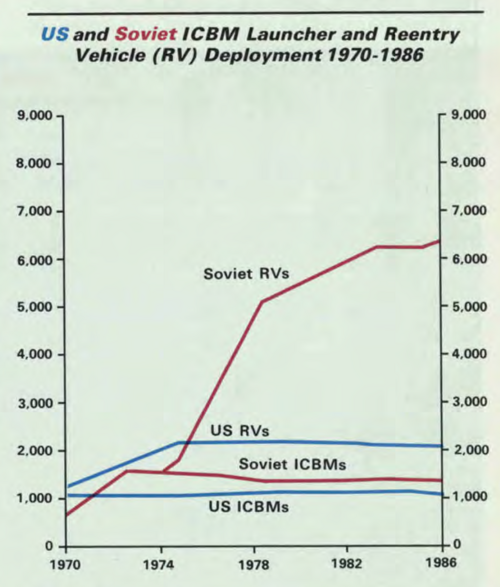
Forest Green
ACCESS: Above Top Secret
- Joined
- 11 June 2019
- Messages
- 9,432
- Reaction score
- 17,176
I agree, which is why SDI combined a number of technologies that would target missiles at different stages of flight. Zenith Star was design to hit the boost stages; brilliant pebbles, ERIS or garage satellites were designed to hit them post boost (either very last stage, warhead bus or RVs (mid-course); and then GBL, HEDI and LEAP were designed for the terminal phase.This is from the 1986 edition of Soviet Military Power showing the estimated number of Soviet ICBMs and reentry vehicles. Even if you figure out how to successfully intercept ICBMs in boost phase, there were still over 1300 ICBMs to hit. That's a lot of targets to destroy simultaneously within only a few minutes on the very first try. One of the many reasons why SDI was such a challenging program.
View attachment 759288
The costs of the space-layer were restrictive back then due to launch costs, but they have reduced ~100-fold thanks to RLVs.
- Joined
- 26 September 2008
- Messages
- 1,960
- Reaction score
- 744
It's still a ridiculously complex task. Putting the stuff in orbit is only one part. Linking all the sensors together, developing a command and control system, and making sure the weapons will actually work, are all really difficult things to do.I agree, which is why SDI combined a number of technologies that would target missiles at different stages of flight. Zenith Star was design to hit the boost stages; brilliant pebbles, ERIS or garage satellites were designed to hit them post boost (either very last stage, warhead bus or RVs (mid-course); and then GBL, HEDI and LEAP were designed for the terminal phase.
The costs of the space-layer were restrictive back then due to launch costs, but they have reduced ~100-fold thanks to RLVs.
Some people have this belief that "if only" enough money had been thrown at SDI, it could have been made to work. But there's a great counter to that. Look at the past 35 years of effort developing better missile early warning systems. It's a very complex history involving numerous starts and stops, programs canceled and delayed. One of the main components was the GEO and HEO-based infrared satellites, and they ultimately entered service a decade after they were supposed to. So from just one component of missile defense we have proof that this stuff is really hard.
Firefinder
ACCESS: Top Secret
- Joined
- 5 October 2019
- Messages
- 1,041
- Reaction score
- 1,889
But is a literal 50 year old hat at this moment.Linking all the sensors together, developing a command and control system, and making sure the weapons will actually work, are all really difficult things to do.
We know how to do it, we have systems that been stress test in real combat showing that in Aegis and Iron Dome.
The bigger issue be ensuring there is no funding stops, no exploit able programing bugs and that there multiple different launch vehicles for use. The last one is the biggy cause originally the Sbirs was to use the shuttles, then Columbia went poof and there was a mad scramble to find a replacement with that getting kneecap due to the Delays, foreseen lack of need, and the 08 recession. Then it turn out someone didn't know how to solder so the entire set up needed to be recheck.
Likely still been delayed, name a post 1950 military program that hasn't, but it likely been 5 years instead of 10.
It is hard but it more politically then technically.
Similar threads
-
-
Laser Battle Station Model Kit Inspiration
- Started by thatdronedude
- Replies: 9
-
-
-



